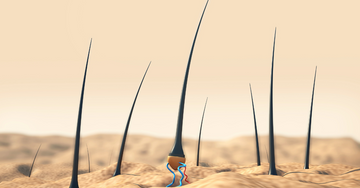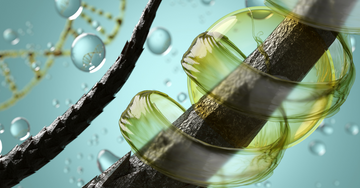A Closer Look at the Scalp's Unique Growth Cycle
Hair, often seen as a symbol of identity and beauty, goes through a continuous cycle of growth, rest, and shedding. This cycle is orchestrated by a complex interplay of cellular activities, with stem cells playing a pivotal role. The scalp, in particular, showcases a unique aspect of hair biology, mainly due to its longer anagen phase (the active growth phase) compared to any other hair-bearing area of the body. Understanding the function of stem cells in hair growth and their impact on the different cycles holds the key to unlocking treatments for various forms of hair loss, including those driven by hormonal changes.
The Foundation of Hair Growth: Stem Cells
Stem cells are the cornerstone of hair follicle regeneration. These cells are uniquely potent, capable of dividing into multiple cell types that either maintain the stem cell population or differentiate to perform specific functions. In the scalp, hair follicle stem cells reside in a niche called the "bulge" area. These cells are crucial for initiating the anagen phase (growth phase), where they proliferate to regenerate the hair follicle, leading to new hair growth.
The Hair Growth Cycle: Anagen, Catagen, and Telogen Phases
The hair growth cycle comprises three distinct phases: anagen (growth), catagen (regression), and telogen (resting). The anagen phase in the scalp is notably longer than in other body regions, lasting anywhere from two to eight years. This extended period allows hair on the scalp to grow much longer.- Anagen Phase: Stem cells are most active during this phase, dividing rapidly to contribute to the formation of new hair shafts. The length of this phase is critical, as it determines the ultimate length of the hair. Around 90% of your hair is in the anagen phase at all times.
- Catagen Phase: This brief transitional phase lasts about two weeks. Hair growth ceases, and the hair follicle shrinks. During this period, a portion of the hair follicle undergoes programmed cell death, but the stem cells remain preserved to enable future cycles.
- Telogen Phase: The final phase is a resting period for the hair follicle, lasting around three months. At the end of this phase known as the Exogen Phase, the hair falls out, and the stem cells are reactivated to start a new cycle.
- Exogen Phase: Is the end of the Telogen phase where the hair falls from the new hair pushing it out, this new Hair is now in the Anagen Phase which forms the life cycle of hair growth.
Stem Cells and Hair Loss: The Hormonal Link
Hormonal hair loss, such as androgenetic alopecia (⬅️Follow link to learn more), affects millions worldwide. This condition is characterized by the miniaturization of hair follicles, shortening the anagen phase and leading to thinner, shorter hairs. The role of stem cells in this process is under intense study, with evidence suggesting that hormonal changes can disrupt the stem cell environment, impairing their ability to regenerate the hair follicle properly.
Moreover, hormonal fluctuations can influence the signalling pathways that regulate stem cell proliferation and differentiation. For example, increased levels of dihydrotestosterone (DHT), a potent androgen, have been linked to the miniaturization of hair follicles in androgenetic alopecia. This suggests that maintaining the health and functionality of hair follicle stem cells could be key to combating hormonal hair loss.
The Future of Hair Loss Treatments: Harnessing Stem Cell Potential
The discovery of the critical role of stem cells in hair growth and regeneration has opened new avenues for treating hair loss. Research by experts in the hair industry are now focusing on finding ways to stimulate these cells to prolong the anagen phase, prevent premature entry into the catagen phase, and enhance the regeneration capacity of hair follicles. These approaches aim to restore the normal hair cycle, promoting healthy hair growth and offering hope to those experiencing hair loss.
Mechanical Interventions and Plant-Based Vasodilators: A Holistic Approach to Prolonging the Anagen Phase
While understanding the role of stem cells in hair growth offers a biological pathway to tackling hair loss, mechanical interventions have also emerged as effective allies in this quest. Techniques such as scalp massage, red light therapy, and micro-needling, especially when combined with plant-based vasodilators, can enhance hair growth by extending the anagen phase and improving the health of hair follicles. Let's explore how these methods work in tandem to combat hair loss.
Scalp Massage: Stimulating Hair Growth
Scalp massage is a gentle, accessible approach to stimulating hair follicles. Regular massage increases blood flow to the scalp, nourishing the hair follicles with oxygen and essential nutrients. This enhanced circulation can awaken dormant stem cells, encouraging them to enter the anagen phase and initiate hair growth. When combined with plant-based oils that possess vasodilatory properties, such as peppermint or rosemary oil, scalp massage can be even more effective. These natural vasodilators further boost blood flow, amplifying the beneficial effects of the massage.
Red Light Therapy: Energizing Hair Follicles
Red light therapy involves exposing the scalp to a specific wavelength of light, which is believed to stimulate energy production in cells and can lead to improved hair growth. This non-invasive technique helps extend the anagen phase, reducing hair loss and promoting thicker, more vibrant hair. The mechanism behind red light therapy suggests that it enhances cellular metabolism and increases blood circulation, creating an optimal environment for hair follicles to thrive. When used alongside plant-based vasodilators, red light therapy can see its effects magnified, leading to more pronounced and faster results.
Micro-needling: A Catalyst for Regeneration
Micro-needling, a procedure that involves creating tiny punctures in the scalp with fine needles, is another promising mechanical intervention. This controlled injury triggers the body's healing response, including the activation of stem cells and increased production of growth factors that are vital for hair regeneration. Micro-needling has been shown to effectively prolong the anagen phase, contributing to denser hair growth. Incorporating plant-based vasodilators into the post-treatment care can further enhance the procedure's effectiveness by improving blood flow to the scalp and ensuring that the rejuvenated follicles receive an abundance of nutrients.
Integrating Mechanical Interventions with Natural Enhancers
The combination of mechanical interventions with plant-based vasodilators represents a holistic approach to hair care. This synergy not only targets the biological aspects of hair growth but also leverages physical stimulation to maximize the health and longevity of hair follicles. For individuals experiencing hair loss, these methods offer a non-pharmacological and less invasive option, with the potential for significant improvements in hair density and length.
In summary, the fight against hair loss is multifaceted, involving a deep understanding of stem cell function and the hair growth cycle, as well as the strategic use of mechanical interventions and natural enhancers. By adopting a comprehensive approach that includes scalp massage, red light therapy, micro-needling, and the use of plant-based vasodilators, individuals can effectively stimulate hair growth and prolong the anagen phase, offering a beacon of hope for those seeking to restore their hair to its natural vitality.
Nutrition that Supports Stem Cell Function.
Nutrition plays a pivotal role in supporting stem cell function and, consequently, hair growth. Certain foods are rich in vitamins, minerals, and other nutrients that can help activate and nourish stem cells, potentially enhancing their ability to regenerate and foster healthy hair follicles. Including these foods in your diet may create a conducive environment for hair growth by supporting the underlying cellular processes. Here are several key foods known for their positive impact on stem cell activation and hair health:
- Leafy Greens
Spinach, kale, and other leafy greens are packed with nutrients like folate, iron, and vitamins A and C, all of which are essential for hair health. Vitamin A helps the skin glands produce sebum, which moisturizes the scalp and helps keep hair healthy. Iron is crucial for hair growth, and its deficiency has been linked to hair loss.
- Berries
Berries are loaded with beneficial compounds and vitamins, particularly vitamin C, which has strong antioxidant properties. Antioxidants can protect hair follicles from damage by harmful molecules called free radicals. Vitamin C also helps produce collagen, a protein that strengthens hair to prevent it from becoming brittle and breaking.
- Fatty Fish
Omega-3 fatty acids found in fatty fish like salmon, mackerel, and herring are known for their anti-inflammatory effects. They can help open up the hair follicles and promote hair growth. Furthermore, omega-3 fatty acids are believed to support the health of cell membranes, potentially enhancing stem cell function.
- Nuts and Seeds
Nuts and seeds are powerhouses of nutrients, including omega-3 fatty acids, zinc, and vitamin E. Zinc is vital for hair growth and repair, while vitamin E provides antioxidant effects to protect hair cells from damage. Flaxseeds, chia seeds, walnuts, and almonds are especially beneficial for hair health.
- Eggs
Eggs are a great source of protein and biotin, two nutrients that are essential for hair growth. Hair follicles are made mostly of protein, making adequate protein intake crucial for hair health. Biotin is necessary for the production of a hair protein called keratin, which is why biotin supplements are often marketed for hair growth.
- Sweet Potatoes
Rich in beta-carotene, which the body converts into vitamin A, sweet potatoes can promote the production of sebum and speed up the rate of hair growth. This nutrient also encourages the growth of thicker hair while protecting against other factors that can lead to hair loss.
- Avocados
Packed with vitamin E, avocados can combat oxidative stress by neutralizing free radicals. Their high content of essential fatty acids, which are considered the building blocks of cells, can also support cell integrity, including that of stem cells vital for hair growth.
Incorporating These Foods for Hair Health
A balanced diet incorporating these foods can support stem cell activation and provide your body with the nutrients it needs for optimal hair growth. However, it's important to remember that results from dietary changes may take time to manifest as the hair growth cycle is relatively slow. Consistency in consuming a nutrient-rich diet, combined with proper hair care and lifestyle choices, can create the right conditions for improved hair health and growth over time.
Everything considered
Understanding the crucial role of stem cells in hair growth highlights the need for a comprehensive strategy when addressing hair health, as no singular approach will likely give you the results you desire to achieve. The key takeaway is that seeing tangible improvements through a holistic approach you’ll need to include diet, mechanical interventions, and topical solutions. This is not a quick fix but a lifestyle commitment, as the natural lifecycle of your hair dictates the pace of visible results. Adopting these practices consistently over the duration of your hair's growth cycle is essential for witnessing a significant transformation.
A recommended routine
- Hair and Scalp Oil Massaged in with a boost brush. Revitalise Dust can be used if exfoliation is needed around follicles.
- Stimulate Shampoo or Hydrated Halo massaged with boost brush as your cleanse routine.
- Reinforcement treatment as a scalp and hair vasodilation treatment.
- Conditioner to suit your hair length.
- Revitalise serum as your scalp and hair growth daily enabler which can be applied after micro-needling if you use this in your routine.





